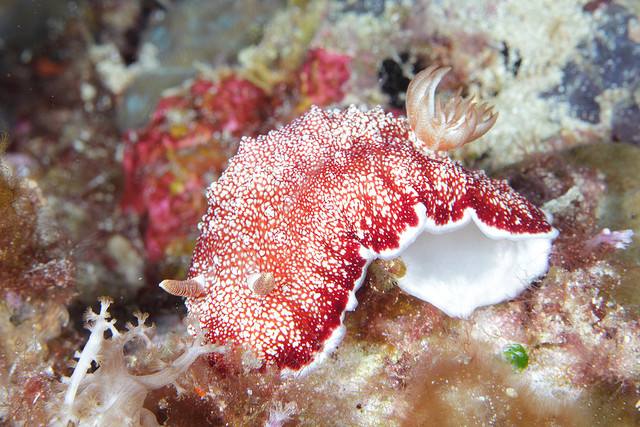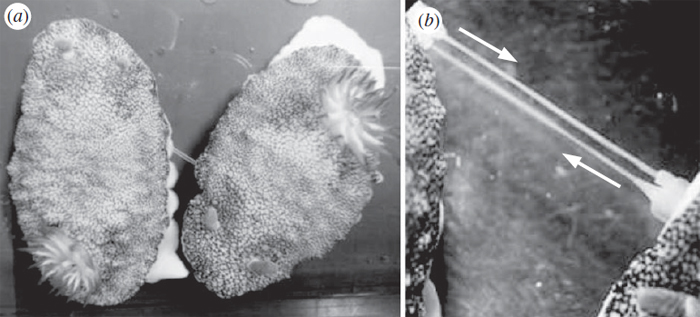Reproduction (part 1)
By Mikayla Beuch
The reproductive procedure is what sets
apart the Chromodoris reticulata from every other species of sea
slug (Sekizawa, et.al. 2013). In fact, the method of reproduction is
so unique, no other living species is ever known to engage in a
process that matches that of the Chromodoris reticulata (Sekizawa,
et.al. 2013). Bees can come close, like the
bumblebee, but even they can't match the uniqueness of the sea
slug. Almost all sea slugs are hermaphroditic (Sekizawa,
et.al. 2013), meaning they contain both male and female reproductive
organs. This makes the process of finding a mate much easier because
they can mate with any other slug of their family. It is important
to note that these sea slugs are simultaneous hermaphrodites
(Sekizawa, et.al. 2013), meaning they exchange their sperm, and
accept the sperm of the other partner at the same time.
During copulation, both slugs extend their penises towards one
another, and exchange sperm. There are two storage pouches in the
female reproductive organs in the slug for the sperm, and the slugs
are also able to digest excess sperm that comes through (Sekizawa,
et.al. 2013).
After the two slugs mate and one becomes fertilized, the eggs grow
into ribbons held in a gelatinous pouch inside the host parent slug
(Wilson, 2002). The sea slug usually has around two to three embryos
per yolk capsule, and the eggs were described to be of an orange
color (Wilson, 2002).
The copulation of two slugs can last anywhere between
ten minutes to five minutes (Sekizawa, et.al. 2013). After
copulation, the slugs removes their penises from one another, and
anywhere between seven minutes and twenty minutes later, the penis
detaches from the original owner (Sekizawa, et.al. 2013).

When examined closely, it can be seen that the penis is covered in
tiny little backward-pointed spikes (Sekizawa, et.al. 2013). These
spikes, after the copulation ended, were covered in entangled sperm,
leading scientists to believe that these spines serve as a method
used to remove previous sperm left behind from other slugs that
mated (Sekizawa, et.al. 2013). It is in this method that leaves the
possibility that sperm competition is high in these sea slugs
(Sekizawa, et.al. 2013).
The detachable penis is only half of the excitement of the
copulation cycle of the Chromodoris reticulata. After the penis
detaches, in roughly twenty four hours, another penis grows from the
same sea slug (Sekizawa, et.al. 2013). This act of regrowth was
studied to occur up to three times after the sea slug mated
(Sekizawa, et.al. 2013). The penis is stored inside of the sea slug
as a coiled up organ, and after each sexual encounter, the next
segment of the penis is grown to fill the void of the last one
(Sekizawa, et.al. 2013). The sea slugs required at least a day
before they were able to continue mating with a new partner again,
the shortest time being 22.4 hours (Sekizawa, et.al. 2013).
Reproduction (part 2)
By Mackensie Bruring
Chromodoris reticulata has one of the most rare and most
observed mating rituals of all organisms. Multiple studies
have found that Chromodoris reticulata, a hermaphrodite, disposes of
its penis after mating (Sekizawa, et al. 2013) as well as maintaining
the body parts to make another penis for future mating between slugs
in a matter of hours (Milius 2013). Both partners also house
sperm exclusively inside its body until it is time to begin mating
(Sekizawa, et al. 2012; Sucati, et al. 2011). Chromodoris
reticulata reproduces by a somewhat sexual, highly competitive,
viewpoint (Sekizawa, et al. 2013) and once the penis grows back in a
matter of hours, it may chose other mates (Milius 2013). There
are different evolutional factors that could lead to the reason
behind the disposal, making it extremely unique and highly observed
(Sekizawa, et al. 2013; Milius 2013).

During one study, it was found that spines were located on the penis which stored the sperm and excreted it during copulation. Also, the head of the penis becomes swollen and when combined with the spines could lead to the reason for the breaking off of the penis rather than the simple withdraw from its partner (Sekizawa, et al. 2013). The sperm located in the barbs may have originated from the individual organism or it may have been stored from previous hermaphrodite partners (Milius 2013). Only a quarter of a penis is used for copulating while the rest stays coiled up internally to replace the fallen off portion (Jameson-Gould 2013). In one study, it was found that the internal penis remains coiled for easier recreation of the external penis and can result in three consecutive penises over a few days (Sekizawa, et al. 2013). In multiple studies, these hermaphrodites both give and receive sperm because of both of the male and female parts (Jameson-Gould 2013) located on the right side of slug (Sekizawa, et al. 2013). In some cases during the copulating (Sekizawa, et al. 2013), the penis may fall off before the process is complete due to the need to move away, yet the fallen off penis is still capable of pumping out semen (Milius 2013). For most other cases, however, the penis will detach only twenty minutes after exchanging sperm between partners (International 2013). Chromodoris reticulata has one of the most unique modes of reproduction and only few other organisms are capable of similar tactics (Milius 2013), but it leaves the slug at a somewhat advantage for competitive, environmental, and self-restorative incentives (Sekizawa, et al. 2013).